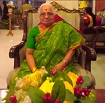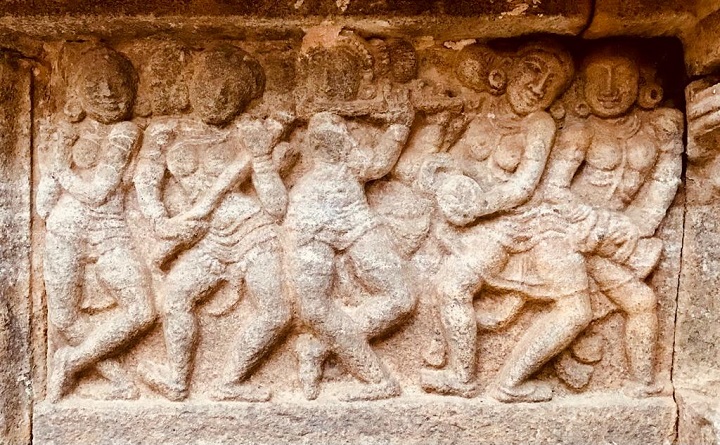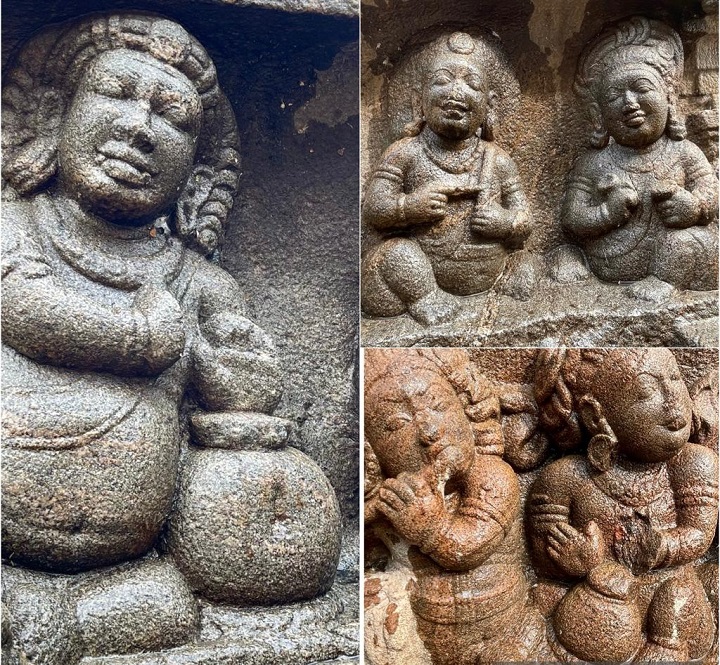 |
 |
 |
http://www.varalaaru.com A Monthly Web Magazine for South Asian History [187 Issues] [1839 Articles] |
 |
 |
 |
http://www.varalaaru.com A Monthly Web Magazine for South Asian History [187 Issues] [1839 Articles] |
|
Issue No. 171

இதழ் 171 [ செப்டம்பர் 2023 ] 
இந்த இதழில்.. In this Issue.. 
|
Author: www.glorioustamils.com; www.attraithingal.com  instruments in darasuram airavatheswarar temple panel- chendu thaalam (concussion), veenai (string), kuzhal (wind), ilai thalam (concussion) and idakkai (percussion) Early Tamil literature, an ocean of information on history and life of ancient Tamils, provides substantial data about various musical instruments prevalent during the- sangam, epic, pallava/pandya (bhakti) and medieval chola ages respectively. Sangam works – ettuthogai and pathupaattu talk of all four kinds of instruments- string, wind, skin headed percussion and concussion. Koothar the dancers and Paanar the instrumentalists travelled in groups with their huge bags of instruments. In Malaipadukadaam or Koothar Aatruppadai, the scene of koothar carrying their packed instruments is portrayed beautifully (Poet Iraniyamuttrathu Perunkundrur Perungkousikanaar, Malaipadukadaam 1-13). The Koothars have packed their musical instruments in drawstring bags that look like ripe jackfruit clusters. And, they carry their bags on balancing poles placed on their shoulders. One can imagine the bulk of instruments which were transported for their performances. The scene would certainly be incomplete without the list of instruments. Among the several instruments, a few were the Muzhavu, Aakuli, Pathalai and Ellari that constitute skin headed percussion; Thoombu and Kuzhal constitute the wood wind instruments; Kodu constitutes the stringed variety; and Paandil- a cymbal that represents metallic/brass instruments. Additionally, there was the ‘Thattai’, a bamboo instrument inducing croaking sounds of frogs played along with other instruments (‘நடுவு நின்று இசை க்கும் அரிக்குரல் தட்டை ’). Artists carrying their cinch bags (draw string), brimming with a wide range of instruments can also be seen in Agananuru ( Poet Athiyan Vinnathanaar, Agam 301). Kodiyar, the dancers who were also instrumentalists travelled to different destinations carrying their several instruments in bags with knotted straps (தலை ப்புணர்த்து அசை த்த பல்த ொகை க் கலப்பை யர்) accompanied by their huge clan. Following Sangam literature, epic Silappadhikaram provides an elaborate vision on dance and music of Tamilagam along with the traditional instruments that continued into the epic era. Kuzhal (wind), yaazh (string), thannumai, muzhavu and aamandhirigai (percussion for rhythm) were the chief instruments played during the maiden performance of Madhavi in Arangetru Kaathai (verses 139-143, arangetru kaathai, silappadhikaaram). One of the pioneers of Indian Bhakthi movement, Karaikkal Ammaiyar (4-5th century CE), who lived before Appar and Sambandhar, presents different instruments of the early decades of the Bhakti era in her hymns. Shiva, the Lord of Dance not only performs to the music of those long list of instruments but also dances playing them. In Karaikkal Ammaiyar’s Mootha Thirupathigam (kongai thirangi – 9), Chachchari, Kokkarai, Thakkai, Thagunichcham, Thunthubi, Thaalam, Veenai, Maththalam, Karadikai, Damarugam, Kudamuzhavu and Monthai are all mentioned in a single poem apart from the ancient yaazh, thudi and parai in other verses. Yet again, all four kinds of instruments get space in the Tamil music and dance arena. Kokkarai/ conch (wind), Veenai (string), thaalam /chendu or ilai thaalam (concussion) are mentioned. Ammai introduces a substantial list of nine percussion instruments – chachari, thakkai, thagunichcham, maththalam, karadikai, kudamuzhavu, monthai, thunthubi and damarugam, unknown to sangam and epic texts. This showcases the impact of dance, music and musical instruments in the lives of Tamils, that continued since centuries prior to common era. Evidences of Musical Instruments  musical instruments in vettuvan kovil, kazhugumalai -kuda muzhavu (percussion), chirattai kinnari (string), thaalam (concussion), kuzhal (wind) Tamilnadu has the unique documentation of details related to music and dance in three different categories – literature, sculpture (stone and bronze), and inscriptions. The continuous sound of ancient instruments performed with Koothu and Aadal from and before the days of Sangam can be heard even today. With time- the purpose, people who played, places of play and importance of the instrument have certainly taken a deviated sociological and anthropological path. Several instruments can be identified as examples of ancient music devices that still have space in today’s society. However, like the life and status of people in society, the life and stature of certain ancient traditional instruments have certainly taken a path downwards. The availability of evidences help in co-relating facts like the structure, sounds and usage (people who used and places they were used) of instruments. Especially, if we analyse the vast period from the Pallava/Pandya period that gave way to later Chola Empire, and then the rise of Vijayanagara Nayakas that encompasses more than 1000 years in the history of today’s Tamilnadu, the uninterrupted sound of music that resonated in the society through temples can be well felt. Though there is a long list of instruments to be studied about, five percussion instruments that possess several common features have always created ambiquities among researchers. Thudi, Damarugam, Udukkai, Thimilai and Idakkai are five skin head gadgets that need to be analysed deeper. With literary, sculptural and inscriptional evidences available, it might seem to be an easy task identifying these. Yet, how these pose confusing questions is an example of history’s several mysteries. Thudi, Damarugam, Udukkai Dr. R. Kalaikkovan’s extensive article ‘துடி, தமருகம், உடுக்கை ‘, clearly identifies Thudi, Damarugam and Udukkai with evidences from literature, sculptures and inscriptions. The author provides convincing details of Thudi from sangam, epic and bhakti literatures; Damarugam exclusively from bhakti literature; and Udukkai from bhakti Literature and Chola inscriptions, besides providing sculptural evidences for all the three instruments. These help in differentiating and identifying the other two- Thimilai and Idakkai. His chapter on ‘artists and instruments during chola period’ in his Tamil book ‘Cholar Kaala Aadarkalai’ aids with further details. Why specifically these five instruments? There seem to be visible similarities as well as underlying differences among these percussion instruments, making the identification itself ambiguous, leaving aside details of how they were played. ● Thudi, Damarugam, Udukkai, Thimilai and Idakkai – all have an hour glass structure. They are aptly called ‘drums with a narrow centre’- ‘Idai Churungu Paraigal / இடை ச்சுருங்குப்பறை கள்’ in tamil ● All five are double sided drums; Except Damarugam, other four are beaten on one side alone ● Thudi, Udukkai and Idakkai are beaten with ‘Kunil’ or a curved stick or with hands without Kunil too ● Thimilai has the distinction of being beaten with both hands on one side ● Damarugam is held with one hand; a small metallic ball is tied to the separate rope around the neck; creating sound from both faces. The musician holds the damarugam with one hand around its narrow neck, moves the instrument by twisting the wrist that makes the metallic ball hit both its faces alternatively, hence creating resonance. To create different rhythms, the narrow centre is pressed while holding the gadget ● Except Damarugam, all four can be hung on shoulders with connected ropes; there are sculptures without shoulder ropes too wherein the artist seems to balance the instrument on his/her thighs ● Again, except Damarugam all four get their different rhythms in general, by pressing the ropes of the narrow part of the hour glass instrument with left hand- not to ignore certain intricate variations though ● The hour glass body with hollow interiors of all these five instruments are made with wood from karungaali (ebony tree), sengaali, verb (neem), pala (jack fruit), kuravam trees; some were also made with metal and sand says ‘Panchamarabu’ ● They get their sound by hitting the side faces which are covered with cow/goat skin ● In all the gadgets, the side faces or animal skin plates have holes on either sides and are connected to each other with tied ropes between the two faces Additional Inferences regarding these five from today’s usage- ● Minute differences can be seen in the placement of the plate with skin- inward or outward, which cannot be identified from sculptures ● Extra fittings for beauty and religious purposes- like the 64 small balls in today’s Idakkai is a new addition ● Variations in size of the drums is clearer from today’s equipments ● Basic materials used have been altered sometimes according to today’s availability-like plastic sheets and nylon ropes have replaced animal skin and palm ropes respectively- easy to make and less time consuming. Music through ages Sangam age was the spectacular era of a cosmopolitan life style of Tamils with a well developed classical language, global merchandise and wide spread arts. Epic era provides more information on the refined status of arts and culture of the three main Kingdoms – Chera, Chola and Pandya. Especially, literature of both these periods is a source of all things related to common man and his society – his land, cattle, flora and fauna, his emotions, passions, ambitions, knowledge, professions, love life, family, war, victory, death, grief and so on. It is also the chief source of documentation on ancient Kings, their Royal and Noble lives and several other spheres connected to them. The streets and shades of trees served as stages for the Sangam Koothar and Viraliyar, and there were separate stages for the elite. Though the dance of the common man still continued on the streets during bhakti era, the art form was predominantly protected under the shade of the temple premises. Bhakti literature, as the name suggests is completely carried away by Gods and their related stories and their reverred devotees, prioritising the need to spread religion. The hymns of Nayanmars and Alwars, the essence of Bhakti literature is a storehouse of facts related to music, dance and instruments. But, the main Dancer of the era was Shiva, who was crowned the Lord of Dance. Hence, the sound of instruments that roared on the streets, stages and royal houses of sangam age, takes a giant leap to reach the Gods and their outer worlds spread across the universe. In light of the drastic changes in the lives, beliefs, kingdoms, literature and art forms of the Tamils with the Bhakti Era, it is essential to understand the ancient and traditional Thudi, that seems to have given the basic structure and rhythm to other instruments – Damarugam, Udukkai, Thimilai and Idakkai. Thudi and its features would be discussed in the next article. Reference books/links- 1. டாக்டர் இரா. கலைக்கோவன், சோழர் கால ஆடற்கலை 2. டாக்டர் இரா. கலைக்கோவன், துடி, தமருகம், உடுக்கை – http://www.varalaaru.com 3. Translation by Vaidehi Herbert, learnsangamtamil.com –மலை படுகடாம், verses 1-13 4. Translation by Vaidehi Herbert, learnsangamtamil.com – Agananuru 301 5. Ilangovadigal, Silappadhikaaram, Arangetru Kaathai, verses 139-143- ‘இளங்கோவடிகள் அருளிச் செய்த சிலப்பதிகார மூலமும் அரும்பதவுரையும் அடியார்க்கு நல்லாருரையும்’, உ.வே .சா. பதிப்பு 6. Karaikkal Ammaiyar, Thiruvaalangaattu Mootha Thirupathigam, (kongai thirangi 9) |

சிறப்பிதழ்கள் Special Issues 

புகைப்படத் தொகுப்பு Photo Gallery 
|
| (C) 2004, varalaaru.com. All articles are copyrighted to respective authors. Unauthorized reproduction of any article, image or audio/video contents published here, without the prior approval of the authors or varalaaru.com are strictly prohibited. | ||